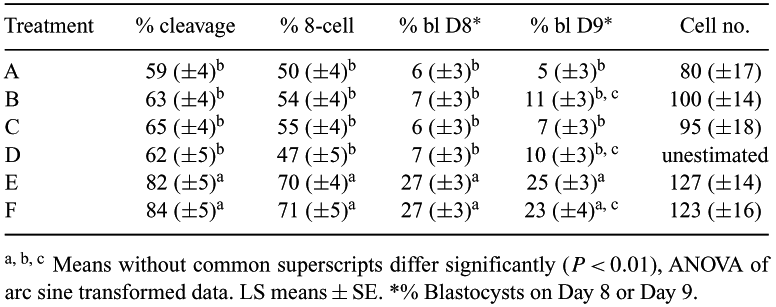99 MACROMOLECULES FOR VITRIFYING BOVINE OOCYTES
G. Horvath A and G.E. SeidelAnimal Reproduction and Biotechnology Laboratory, Colorado State University, Fort Collins, CO, USA. email: gseidel@colostate.edu
Reproduction, Fertility and Development 16(2) 171-171 https://doi.org/10.1071/RDv16n1Ab99
Submitted: 1 August 2003 Accepted: 1 October 2003 Published: 2 January 2004
Abstract
Vitrification of oocytes would make them available for research and clinical purposes wherever and whenever needed. However, development rates and quality of blastocysts arising from vitrified oocytes have been low. Zona hardening following exposure to vitrification solutions and cooling could contribute to low fertilization rates. Addition of fetal calf serum (FCS) to handling media and vitrification solutions can prevent zona hardening, but FCS may be detrimental to resulting embryos and spread viral diseases, and its composition varies among batches. Fetuin is the component responsible for the protective effect of FCS (Landim-Alvarenga FC et al., 2002 Anim. Reprod. Sci. 71, 181–191). Our objective was to determine whether fetuin is a suitable substitute for FCS during vitrification. Oocytes derived from slaughterhouse ovaries were matured in a chemically defined medium with hormones and with or without 1 mg mL−1 fetuin at 39°C in 5% CO2 in air. At 22 h after the start of maturation, oocytes were transferred to one of the following handling media: 2% BSA, 2% BSA + 1 mg mL−1 fetuin, or 20% FCS in TCM-199 + HEPES (HTCM-199). In the same media plus 100 IU mL−1 hyaluronidase, cumulus cells were partly removed by gentle pipetting. Oocytes with approximately 3 layers of cumulus were chosen for two-step vitrification. First, they were exposed to VS1 (10% ethylene glycol (EG), 10% DMSO, 6% PVP in HTCM-199) for 30 s, then to VS2 (20% EG, 20% DMSO, 6% PVP, 0.48 M galactose in HTCM-199) for 25 s, loaded into cryoloops in groups of five, and plunged into liquid nitrogen. Rapidly warmed oocytes were moved stepwise in 0.5, 0.25, 0.125, and 0 M galactose in HTCM-199 + 20% FCS, 3 min each. All procedures were conducted at 39°C. Warmed oocytes were placed in maturation medium for an additional hour, and then fertilized and cultured according to standard procedures (Olson SE and Seidel GE Jr 2000 J. Anim. Sci. 78, 152–157). About 2000 oocytes were used in 11 replicates with semen of 4 bulls. The experimental treatments and controls were: A: maturation BSA, handling BSA; B: maturation BSA, handling FCS; C: maturation BSA, handling BSA + fetuin; D: maturation BSA + fetuin, handling BSA + fetuin; E: non-vitrified control, maturation BSA; F: non-vitrified control, maturation BSA + fetuin (Table 1). Controls did not differ (P > 0.1) from each other, nor were there differences among vitrification treatments. Controls resulted in greater cleavage and more 8-cell embryos and blastocysts than vitrified treatments, and also tended to have higher cell numbers. In summary, fetuin can replace FCS during handling without decreasing the success of vitrification.

|


